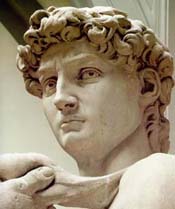|
Mayor Rudolph Guiliani wants to see a
"soaring monumental memorial" at the former World Trade Center site.
Agreed. We need something to stare down the graveyard of cement and steel that
buried so many. We need to see our collective hearts and minds at the site. Now
comes the hard part: How do you show the soul of a nation? How do you memorialize
lost lives? The late sculptor Isamu Noguchi said that sculpture should be experienced,
not just looked at. What image would do that?
The answer can make or
break the project. In 1947, New York mayor William O’Dwyer also sought a monument
to lost lives, the heroes of the Warsaw Ghetto Battle and the six million Jews
of Europe. But it was never built. No one could agree on the imagery. Proposals
were seen either as too morbid, too large or—unaccountably—too unrelated to American
history.
 | Maybe
we ought to look to Europe for inspiration. People there have been at monuments
longer. Michelangelo’s "David" comes to mind. The sculpture was installed
in front of a seat of Florentine government, the Palazzo Vecchio more than 500
years ago, and it was a hit from the start. Vasari , an historian at the time,
says that "David" was intended as a symbol of liberty, signifying that
just as the shepherd boy protected his people and governed them justly as their
king, so whoever ruled Florence should vigorously defend the city and govern it
with justice.
That’s his
opinion. But by calmly facing Goliath while furtively palming a stone in one hand
and with the sling flung casually over his shoulder, "David" comes across
more as an icon of governed might than warrior. The figure stands for reflection
before battle rather than the usual image of victory afterwards. That reining
in of inner strength can be seen in the figure’s steadfast and focused posture.
As well, "David" is everyman, a picture of human uncertainty, as
well as heroism. His gaze is not only intense, but also anxious. His furrowed
brow tells you that. Even from behind, there is an unsure gesture that surfaces
in a slight bend forward.  |
We
need a "David." He’s not a warmonger. Neither was the father of our
country, which is why the initial proposal to memorialize him never was erected.
The Continental Congress voted for an equestrian statue with General Washington
in Roman dress, his battle victories inscribed on the pedestal. Too monarch-like,
said the critics, and too militaristic. So America got a sculpture with no image.
It got a metaphor. A 555-foot obelisk on the Mall in Washington, D.C. the Washington
Monument presents a reaching gesture, a stark soaring, as if to new heights for
all Americans. It was supposed to be a national monument, but the Statue of Liberty,
erected a year later, assumed that mantel. The one-hundredth anniversary for each
tells that story. Compared to the highly publicized extravaganza for Miss Liberty,
the celebration of the Washington Monument went largely unnoticed. Where
does that leave the WTC memorial? If Miss Liberty is any example, probably the
WTC memorial should be figurative, but with the caveat that it not be maudlin.
We don’t want some visual counterpart to entries in the annual Bulwer-Lytonn Fiction
Contest, the bad-writing event that calls for the worst histrionic opening sentence
to an imagined novel, as in "It was a dark and stormy night." That
September 11 morning was our dark and stormy night. We need to counter it with
a monument—tall as a flagpole—that generates awe. We need a great presence neutral
in nothing, a reed in our storm. But likeable. We need a latter-day Michelangelo
for this one. |